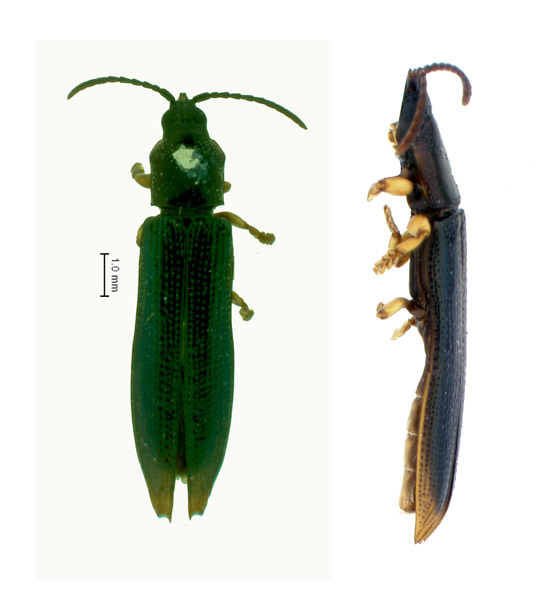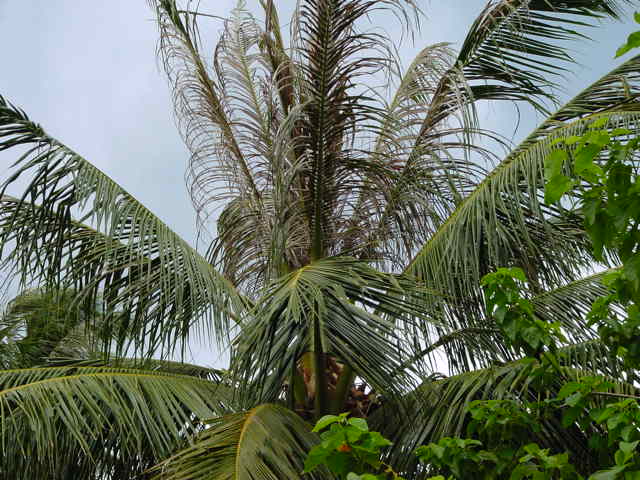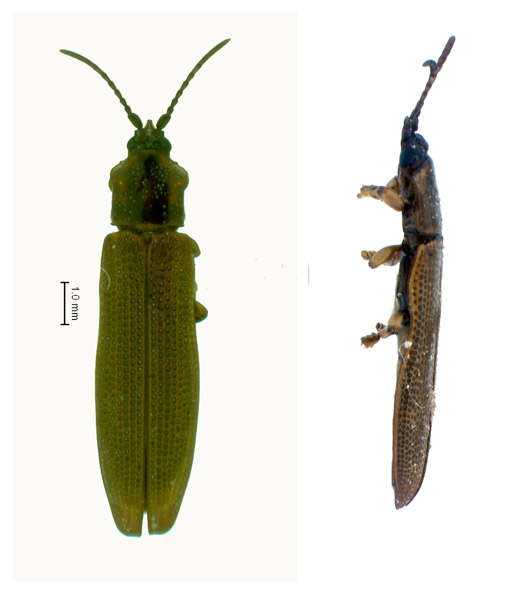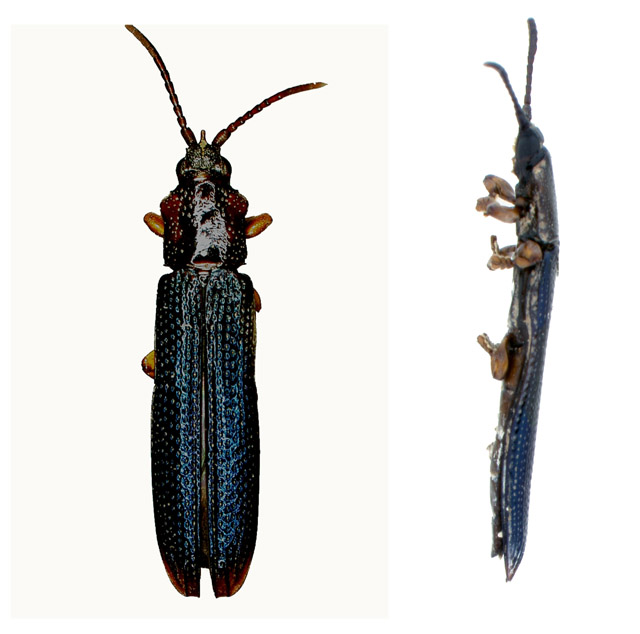Brontispa
|
Brontispa castaneipennis |
|
Brontispa chalybepennis |
|
Brontispa damage |
|
Brontispa longissima |
|
Brontispa mariana |
|
Brontispa palauensis |
Introduction
The genus Brontispa Sharp (Coleoptera: Chrysomelidae: Cassidinae) contains 22 described species. Species are difficult to separate, and the genus is in need of revision. Seventeen species have been reported feeding on various palms (Staines 2012). Brontispa longissima (Gestro) is the best studied species (Froggatt 1914; Koningsberg 1915; Awibowo 1934; Risbec 1934, 1935, 1937, 1942; Lever 1935; Froggatt & O’Connor 1941; Brown & Green 1958; Smee 1965; Stapley 1973, 1980; Kalshoven 1981; Liebregts & Chapman 2004; Zhang et al. 2004; Zhou et al. 2004 ; Zhong et al. 2005; Lie et al. 2006; Xiao et al. 2006; Giang & Nakamura 2009; and Takano et al. 2012) and is discussed in the Damage and Life History Notes sections.
Distribution
Brontispa chalybeipennis (Zacher) is found in Hawaii, Kosrae, Marshall Islands, Palau Islands, and Ponape.
Brontispa gleadowi Weise is found in Mauritius.
Brontispa limbata (Waterhouse) is found in Mauritius and Rodriquez.
Brontispa linearis Spaeth is found in New Guinea.
Brontispa longissima (Gestro) is found in Australia (Lord Howe Island, Northern Territory), Bismarck Islands, Cambodia, China (Guangdong, Hainan), Indonesia (Celebes, Java, Moluccas, Sumatra), Japan (Ryukyu Islands), Laos, Malaysia, Myanmar, New Caledonia, New Hebrides, Papua New Guinea, Philippines, Samoa, Solomon Islands, Sri Lanka, Tahiti, Taiwan, Thailand, and Vietnam.
Brontispa mariana Spaeth is found in Micronesia (Rota, Saipan, Tinian, Truk, and Yap).
Brontispa palauensis (Esaki & Chûjô) is found in Guam and Palau.
Hosts
Brontispa chalybeipennis feeds on Cocos nucifera L., Exorrhiza ponapensis (Arecaceae) (Zacher 1915) and Pandanus sp. (Pandanaceae) (Maddison 1993).
Brontispa gleadowi feeds on Cocos nucifera L. (Arecaceae) (Maulik 1938).
Brontispa limbata feeds on palm (Lepesme 1947); Dictyosperma album Wendl., Acanthophoenix crinita Wendl., Mascarena revaughanii, Chrysalidocarpus madagascariensis Becc., and Rhapis sp. (Jolivet 1979) (Arecaceae).
Brontispa longissima feeds on Howea forsteriana (C. Moore & F. Muell.) Wendl. & Drude (Lea 1929); Areca cathecu L. (Lever 1937); Latania sp., Oreodoxa regia H.B.K, Elaeis guinennsis Jacq., Thrinax parviflora Swartz (Lepesme 1947); Kentia sp. (Howard & Abad 2001); Cocos nucifera L., Archontophoenix alexandrae (F. Müll.) H. Wende & Drude, Caryota sp., Metroxylon sagu Rottb., Bentnickiopsis sp., Balaka sp., Calamus sp., Roystonea regia H. B. K., Washingtonia filifera Wendl., W. robusta H. Wendl., Hyophorbe lagenicaulis (L. H. Bailey) H. E. Moore, Livistona chinensis R. Br., Chrysalidocarpus lutescens (Bory) Wendl. (Yueguan & Yankun 2004); Areca triandra Roxb., Caryota cumingii Lodd. ex. Mart., C. ochlandra Hance, Phoenix hanceana Hort. ex. Wendl., Ravenea rivularus Jum. & H. Perrier, Syagrus romanzoffiana (Cham.) Glassman (Wu et al. 2006); Collinia elegans Liebm., Phoenix canariensis Hort. ex. Chabaud, Rhapis excels (Thunb.) A. Henry, R. humilis Blume (Yamashita & Takasu 2010); and Satakentia liukiuensis (Hatusima) H. E. Moore (Takasu et al. 2010); Dypsis lutescens (H. Wendl.) Beentje & J. Dransf., Mascarena lagenicaulis L.H. Bailey, and Veitchia merrillii (Becc.) H.E. Moore (Kawazu et al. 2012) (Arecaceae). Survival, fecundity, and development is best on Cocos nucifera.
Brontispa mariana feeds on Cocos nucifera L. (Maulik 1937) and Areca catechu L. (Nair & Daniel 1982) (Arecaceae).
Brontispa palauensis feeds on Cocos nucifera L. (Arecaceae) (Esaki & Chûjô 1943) and Pandanus sp. (Pandanaceae) (Maddison 1993).
Damage
Brontispa longissima affects palm seedlings, mature coconut trees, and ornamental palms; however, palms up to five years old are at the greatest risk of infestation. Adults feed on unopened young fronds; as the spear unfurls, the beetle moves on to other palms or the next emerging spear; it does not attack leaves that are already emerged. Beetle larvae chew large areas of the leaflets killing the underlying tissues and reducing photosynthesis; photosynthesis may be reduced to zero in the case of heavy beetle attacks. The adult feeding removes strips of tissue from both the upper and lower leaf surface, and results in brown patches of various sizes and light brown streaks parallel to the mid-rib. As feeding progresses, the feeding lines merge with each other and the remaining tissue dries up and decomposes. The brown leaves then shrivel and curl giving infested plants a scorched appearance.
Beetle attacks result in the reduction of the amount of reserves available to the plant to produce new growth or form reproductive structures; flower and fruit and, subsequently, “nut” production are significantly reduced. Infested palms are more susceptible to drought and fungal rot. Severe infestations may result in the complete defoliation of the palm; in the worse cases palms, especially young ones, die from severe infestation. Most feeding damage is from the fifth-instar larva.
Life history notes
Adult B. longissima is from 8 to 12 mm in length and varies in color from reddish-brown to black. Many of these color forms have been described as separate species or subspecies but currently they are all treated as one species. Takano et al. (2011a) suggest there are two cryptic species in the current species concept of B. longissima based on mitochondrial DNA analysis and laboratory crosses.
It is a small, elongate, flattened beetle which lives between unopened palm fronds. The species is not a true leaf miner but feeds within the unfurled palm fronds (adpressed leaf feeder). Development requires from five to eight weeks and females lay an average of 120 eggs each. Eggs are brown, flat, and are laid in chains of 1-4 on the unopened fronds. They are protected by leaf debris and hatch in 3-5 days. The newly hatched larva is whitish and feeds on fronds for about 5 weeks but developmental time varies according to location and temperature: 33-54 days in the New Hebrides; 30-40 days in New Guinea; average of 30 days in Solomon Islands; and 23-43 days in Celebes. The free moving pupa is found in the unopened fronds and adults emerge in 4-6 days. The total life cycle is from 5 to 9 weeks. Adult beetles may live up to 220 days.
Takano et al. (2012) studied the development of B. longissima in the laboratory. They found that larvae completed their development between 20-30°C; larvae reared at 31°C failed to pupate. Development was completed at the effective cumulative temperature of 891.2 degree-days. With an estimated lower developmental threshold of 13.3°C which is similar to the 16°C reported by Zhong et al. (2005).
Female beetles feed for two to three weeks before producing viable eggs. Kawazu et al. (2012) found that female beetles would copulate immediately after emergence, males did not copulate until three weeks after emergence. Most copulation occurs in the early morning or afternoon.
Kawazu et al. (2011) identified a female contact sex pheromone in B. longissima. While Fang et al. (2011) found that both sexes were attracted by a mixture of two coconut palm leaf volatiles and that the female sequestered both compounds and released them during oviposition. Takano et al. (2011b) suggested that B. longissima preferably feeds on C. nucifera but that field-collected adults initially showed a preference for the plant species on which they were collected.
Bibliography
Awibowo, R. 1934. De Klapperbladkever Brontispa froggatti selebensis en zijn biologische bestrijdin op Celebes. Landbouw 10: 76-91.
Brown, E. S. & A. H. Green. 1958. The control by insecticides of Brontispa longissima (Gestro) (Coleopt. Chrysomelidae-Hispinae) on young coconut palms in the British Solomon Islands. Bulletin of Entomological Research 49: 239-272.
Esaki, T. 1943. Insect pests of Micronesia. Coconut pests. Botany and Zoology (Tokyo) 11: 269-274. [in Japanese]
Fang, Y., J. Sun, & Z. Zhang. 2011. Response of Brontispa longissima to coconut palm (Cocos nucifera) leaf volatiles. Physiological Entomology 36: 321-326.
Froggatt, J. L. & B. A. O’Connor. 1941. Insects associated with the coco-nut palm. Part II. Papua and New Guinea Agricultural Journal 7: 125-133.
Froggatt, W. W. 1914. Pests and diseases of the coconut palm. Department of Agriculture, New South Wales Science Bulletin 2 (3): 1-63.
Giang, H. T. T. & S. Nakamura. 2009. The study on biological characteristics of Brontispa longissima (Gestro) (Coleoptera: Chrysomelidae). Journal of Science and Development 7 (2): 159-164.
Howard, F. W. & R. G. Abad. 2001. Coleoptera. pp. 81-104 in F. W. Howard, D. Moore, D. M. Giblin-Davis, & R. G. Abad (eds). Insects on palms. CABI Publishing. Wallingford.
Jolivet, P. 1979. Reflexions sur l’ecologie, l’origine et la distribution des Chrysomelides (Col.) Des Iles Mascareignes, Ocean Indien, avec la description de deux especes nouvelles. Bulletin Mensuel de la Société Linnéenne de Lyon 48 (10): 606-608, 641-643.
Kalshoven, L. G. E. 1981. Pests of crops in Indonesia. P. T. Ichtiar Baru-Van Hoeve, Jakarta, Indonesia. 701 pp.
Kawazu, K., W. Gugeno, A. Mochizuki, S-I. Takano, M. Murata, R. T. Ichiki, & S. Nakamura. 2012. Age in relation to copulation, egg development, and multiple mating behavior in the coconut palm pest Brontispa longissima (Coleoptera: Chrysomelidae). Annals of the Entomological Society of America 105 (5): 746-750.
Kawazu, K., R. T. Ichiki, D. T. Dang, & S, Nakamura. 2011. Mating sequence and evidence for the existence of a female contact sex pheromone in Brontispa longissima (Coleoptera: Chrysomelidae). Japan Agricultural Research Quarterly 45 (1): 99-106.
Koningsberger, J. C. 1915. Java Zoologisch en Biologisch. Drukkerij Dep. v. L. N. en H. Buitenzorg. 663 pp.
Lea, A. M. 1929. Notes on some miscellaneous Coleoptera. With descriptions of new species. Part VII. Transactions and Proceedings of the Royal Society of South Australia 53: 203-244.
Lepesme, P. 1947. Les insectes des palmiers. Lechevailer, Paris. 903 pp.
Lever, R. J. A. 1935. Brontispa leaf beetles and their parasite Tetrastichodes in the Austro-Malayan Region. British Solomon Islands Agricultural Gazette 3 (4): 10-11.
Lever, R. J. A. 1937. Economic insects and biological control in the British Solomon Islands. Bulletin of Entomological Research 28: 325-331.
Li, Y., L. Cheng, Z. Peng, & R. Ju. 2006. Influence of developmental stage of host plant leaves on the larval development and survival of Brontispa longissima (Gestro). Chinese Journal of Tropical Agriculture 26: 17-20. [in Chinese]
Liebregts, W. & K. Chapman. 2004. Impact and control of the coconut hipine beetle, Brontispa longissima Gestro (Coleoptera: Chrysomelidae). Pp. 19-25 in Anonymus (ed.). Report of the expert consultation on coconut beetle outbreak in APPPC member countries. RAP Publication 2004/29.
Maddison, P. A. 1993. UNDP/FAO-SPEC Survey of Agricultural Pests and Diseases in the South Pacific, Technical report. Vol. 3. Pests and other fauna associated with plants, with botanical accounts of plants. Auckland : Manaaki Whenua B Landcare Research. [File downloaded from http://nzac.landcareresearch.co.nz/]. 553 pp.
Maulik, S. 1937. Distributional correlation between Hispine beetles and their host plants. Proceedings of the Zoological Society of London, Ser. A: 129‑159.
Maulik, S. 1938. On the structure of larvae of hispine beetles-V. Proceedings of the Zoological Society of London B 108: 49-71.
Nair, C. P. R. & M. Daniel. 1982. Pests. Pp. 151-184 In: Bavappa, K. V. A., M. K. Fair, & T. P. Kumar. The arecanut palm (Areca catechu Linn.). Central Plantation Crops Research Institute. Kerala, India. 340 pp.
Risbec, J. 1934. Le cocotier en Nouvelle-Calédonie. L’Agronomie coloniale 23 (199): 1-13.
Risbec, J. 1935. Note préliminaire sur les principaux parasites du cocotier aux Nouvelles-Hébrides. Annales de la Société Entomologique de France 104: 159-173.
Risbec, J. 1937. Observations sur les parasites des plantes cultivées aux Nouvelles-Hébrides. Faunae des Colonies Françaises 4 (1): 1-214.
Risbec, J. 1942(1944). Observations sur les insectes des plantations en Nouvelle-Calédonie. Secrétariat d’État aux Colonies, Direction des Affaires Économiques Section Technique d’Agriculture Tropicale. Paris. 128 pp.
Smee, L. 1965. Insect pests of Cocos nucifera in the territory of Papua and New Guinea: Their habits and control. Papua and New Guinea Agricultural Journal 17 (2) :51-64.
Staines, C. L. 2012. Tribe Cryptonychini. Catalog of the hispines of the world (Coleoptera: Chrysomelidae: Cassidinae). http://entomology.si.edu/Collections_Coleoptera.html
Stapley, J. J. 1973. Insect pests of coconut in the Pacific Region. Outlook on Agriculture 7: 211-217.
Stapley, J. H. 1980. Coconut leaf beetle (Brontispa) in the Solomons. Alafua Agricultural Bulletin 5 (4): 17-20.
Takano, S-I., A. Mochizuki, K. Konishi, K. Takasu, J. C. Alouw, D. S. Pandin, & S. Nakamura. 2011a. Two cryptic species in Brontispa longissima (Coleoptera: Chrysomelidae): Evidence from mitochondrial DNA analysis and crosses between the two nominal species. Annals of the Entomological Society of America 104 (2): 121-131.
Takano, S., K. Takasu, R. T. Ichiki, T. Fushimi, & S. Nakmaura. 2011b. Induction of host-plant preference in Brontispa longissima (Gestro) (Coleoptera: Chrysomelidae). Journal of Applied Entomology 135 (8): 634-640.
Takano, S-I., K. Takasu, T. Fuschimi, R. T. Ichiki, & S. Nakamura. 2012. Life history traits and damage potential of an invasive pest Brontispa longissima (Coleoptera: Chrysomelidae) on Satakentia liukiuensis. Entomological Science 15: 238-245.
Takasu, K. S-I. Takano, K. Konishi, & S. Nakamura. 2010. An invasive pest Brontispa longissima (Gestro) (Coleoptera: Chrysomelidae) attacks an endemic palm in the Yaeyama Islands, Japan. Applied Entomology and Zoology 45 (1): 137-144.
Wu, Q., G-W. Liang, L. Zeng, & L-Y. Lu. 2006. Host plants and natural enemies for the coconut leaf beetle, Brontispa longissima, in Shenzhen. Chinese Bulletin of Entomology 43 (4): 530-534. [in Chinese]
Xiao, G-J., L. Zeng, Q. Li, & Y-Y. Lu. 2006. Cold hardiness of palm leaf beetle, Brontispa longissima. Chinese Bulletin of Entomology 43 (4): 527-530. [in Chinese]
Yamashita, A. & K. Takasu. 2010. Suitability of potential host plants in Japan for immature development of the coconut hispine beetle, Brontispa longissima (Gestro) (Coleoptera: Chrysomelidae) Japanese Agricultural Research Quarterly 44 (2): 143-149.
Yueguan, F. & X. Yankun. 2004. Occurrence and control of coconut leaf beetle in China. Pp. 35-38 in Anonymus (ed.). Report of the expert consultation on coconut beetle outbreak in APPPC member countries. RAP Publication 2004/29.
Zacher, F. 1915. Neue und wenig bekannte Pflanzenschadlinge aus unseren Kolonien. Zeitschrift für wissenschaftliche Entomologie 2: 422-426.
Zhang, Z-X., D-M. Cheng, D-X. Jiang, & H-H. Xu. 2004. Spread, damage and control methods of Brontispa longissima. Entomological Knowledge 41 (6): 522-526. [in Chinese]
Zhong, Y., L-I. Hong, K. Lui, H. Wen, Q-A. Jin, & Z-Q. Peng. 2005. Effects of temperature on Brontispa longissima population growth. Chinese Journal of Applied Ecology 16 (12): 2369-2372. [in Chinese]
Zhou, R., L. Zeng, G-W. Liang, Y-Y. Lu, & Z-X. Cui. 2004. Life history of the laboratory population of the palm leaf beetle Brontispa longissima. Entomological Knowledge 41 (4): 336-339. [in Chinese]








